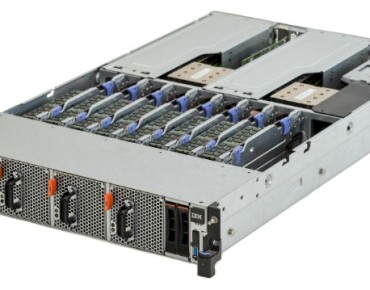IBM Unveils Power8 Linux Servers

Not long after revealing more details about its next-gen Power9 chip due in 2017, IBM has rolled out three new Power8-based Linux servers and a new version of its Power8 chip featuring on-chip NVLink interconnect. One of the servers – Power S822LC for High Performance Computing – uses the new chip (Power8 with NVLink) to communicate with P100 Pascal GPUs, NVIDIA’s most recent and highest performing GPU.
The other servers – the Power S821LC and the Power S822LC for Big Data – also leverage GPU acceleration technology (K80 or P100) via PCIe interface and have IBM’s Coherent Accelerator Processor Interface (CAPI) for use with flash storage and FPGAs. All three servers are standard two-socket additions to IBM’s Linux line.
The introduction also illustrates IBM's growing commitment to Linux as evidenced by its roll out last year of a series of Linux-based mainframes along with parallel Linux initiatives aimed at developing new software distributions for the Linux servers along with expanded support for IBM z Systems virtualization.
The latest introductions, according to Sumit Gupta, vice president of high performance computing and analytics, IBM, should be seen as proof of IBM’s ongoing commitment to accelerated computing as the new paradigm, and of cognitive computing (writ large) and big data analytics as the major drivers.
Also noteworthy is that the new systems are manufactured by partners. “All three of these OpenPOWER systems leverage the strengths and expertise of OpenPOWER partners, from acceleration capabilities to strengths in design and manufacturing. In the spirit of open we hope that our Industry partners who are manufacturing these systems, Wistron, an OpenPOWER partner, and Supermicro, will deliver POWER-based servers to their clients through their routes to market in order to proliferate the OpenPOWER ecosystem,” said Gupta.
IBM says the S822LC for High Performance Computing with NVLink embedded at the silicon level “enables data to flow 5x faster” than on a comparable x86-based system. It also substantially reduces the programming barrier to aggressive use of GPUs according to Gupta who has written a more detailed blog on the introductions. This is the first Power8-based system delivered with NVLink according to IBM.
“Moving data from the CPU to the GPU [has been the] bottleneck because with most systems most of it is going through this thin pipe, PCIe. With NVLink the GPU has access to up to half a TB of memory that sits on the CPU side of that interconnect,” Gupta said in in interview. NVLink allows improved transfer of data between both processors which fundamentally makes it easier to program.
“When an application starts, all the data is sitting in the system memory, and you’ve got to move chunks of it over to the GPU. NVLink does three things. It improves the performance because we’ve enabled a fatter pipe between the processors. It enables you to move smaller functions. And it makes programming accelerators easier because you have to do less data management.”
The new POWER8 with NVLink processor features 10 cores running up to 3.26 GHz. POWER8 processors in this server have higher memory bandwidth than x86 CPUs, at 115 GB/s and can have as much as half a terabyte of system memory per socket. There are larger caches per core inside the POWER8 processor, and this coupled with the faster cores and memory bandwidth leads to higher application performance and throughput.
The new NVIDIA Tesla P100 GPU accelerator increases floating point performance, delivering 21 teraflops of half-precision, 10.6 teraflops of single-precision, and 5.3 teraflops of double-precision performance. The accelerator includes 16 gigabytes of the HBM2 stacked memory with an on-GPU memory bandwidth of 720 gigabytes per sec (GB/s). The NVIDIA Tesla P100 with NVLink GPU in the SXM2 form factor delivers 14 percent more raw compute performance than the PCI-E variant.
In making the announcements, IBM continued ratcheting up its ‘we’re-better-than-Intel’ rhetoric. Its broad application targets encompass all things big data and analytics, as well as deep learning and cognitive computing.
“The big advantage we are seeing for Power8 in the market has been around data analytics, databases, and high performance computing for machine learning and deep learning, and artificial intelligence,” said Gupta. “Because we have faster cores, we see much better performance, [for example], on databases compared to Intel-based systems. Applications like kinetica, which is an accelerated (GPU optimized) database for deep learning and machine learning, gets the value of NVLink high speed data connection between CPU and GPU.”
Recognizing the uphill battle in winning x86 market share, IBM in the past has emphasized efforts to penetrate hyper-scalers as pivotal to its success.
According to IBM, “Early testing with one of the world’s largest Internet service providers (Tencent) based in China has shown that a large cluster of the new Power S822LC for big data servers was able to run a data-intensive workload three times faster than its former x86-based infrastructure. Moreover, this result was achieved while reducing the total number of servers used by two-thirds. Given the significant cost benefits of using fewer servers to deliver faster performance, the company is now integrating the new LC servers into its hyperscale data center for big data workloads.”
Building an ecosystem is hard. For IBM and OpenPOWER, many of the diverse pieces needed are seemingly falling into place. Time will tell.
For additional details, see the full story on our sister web site HPCwire.











